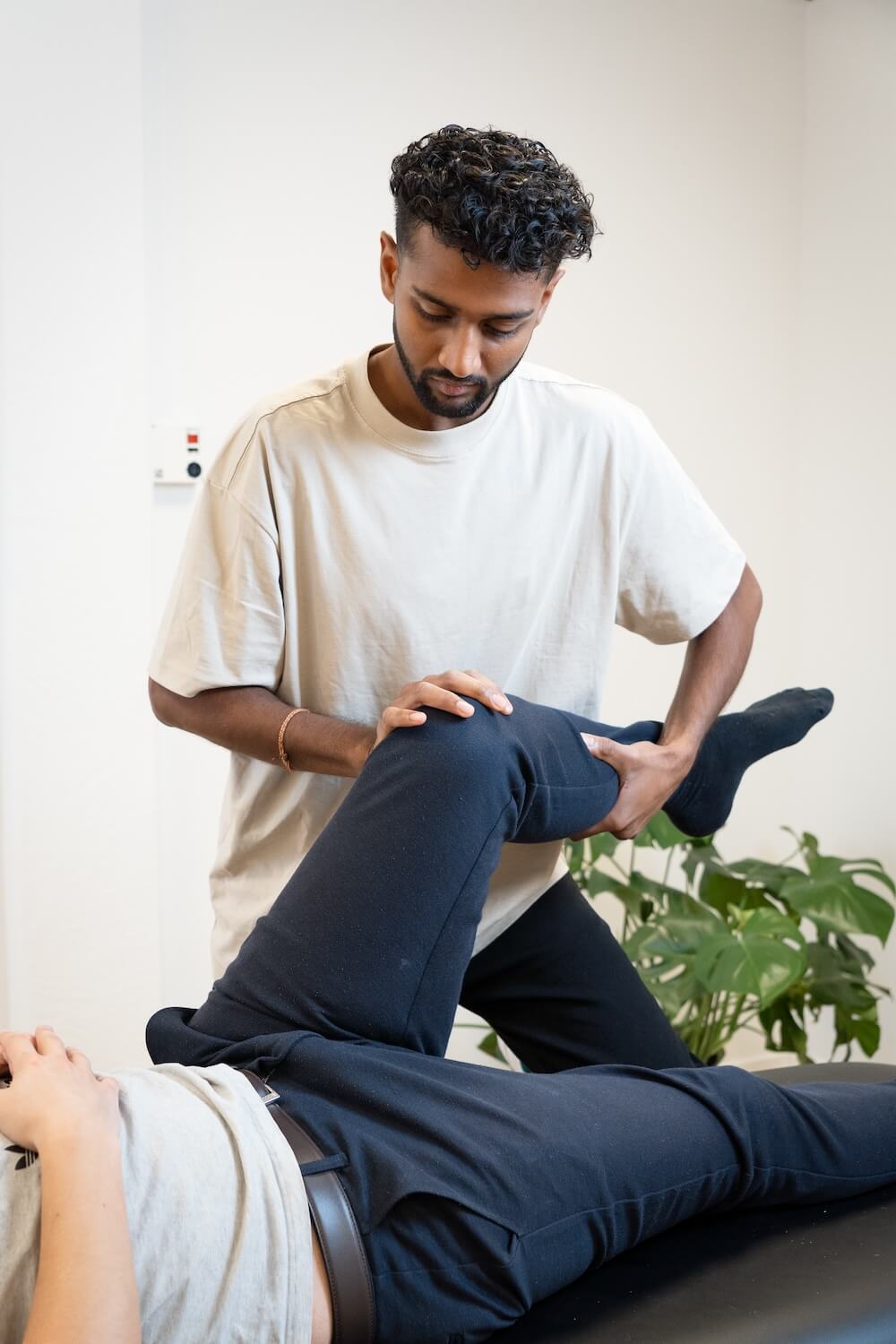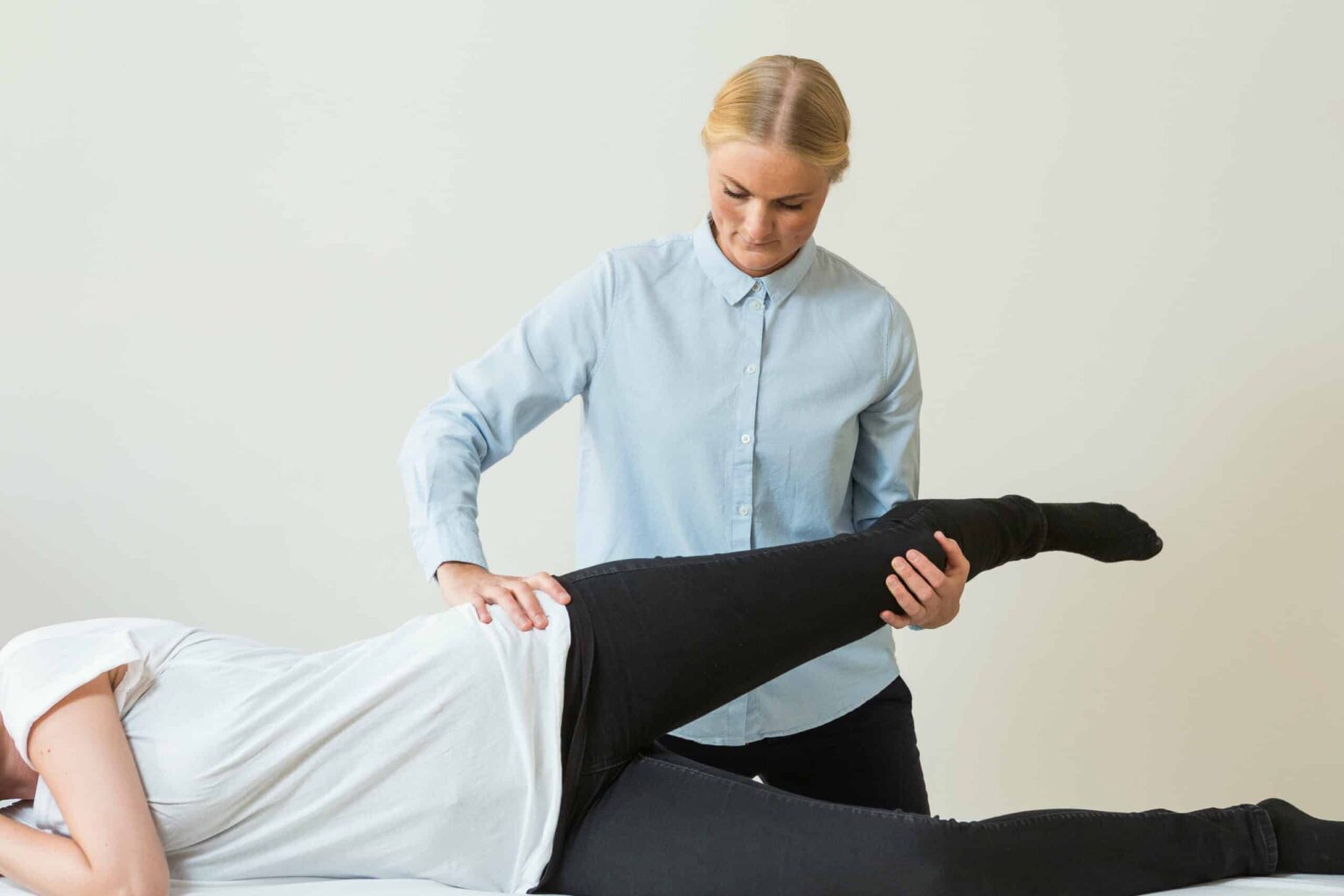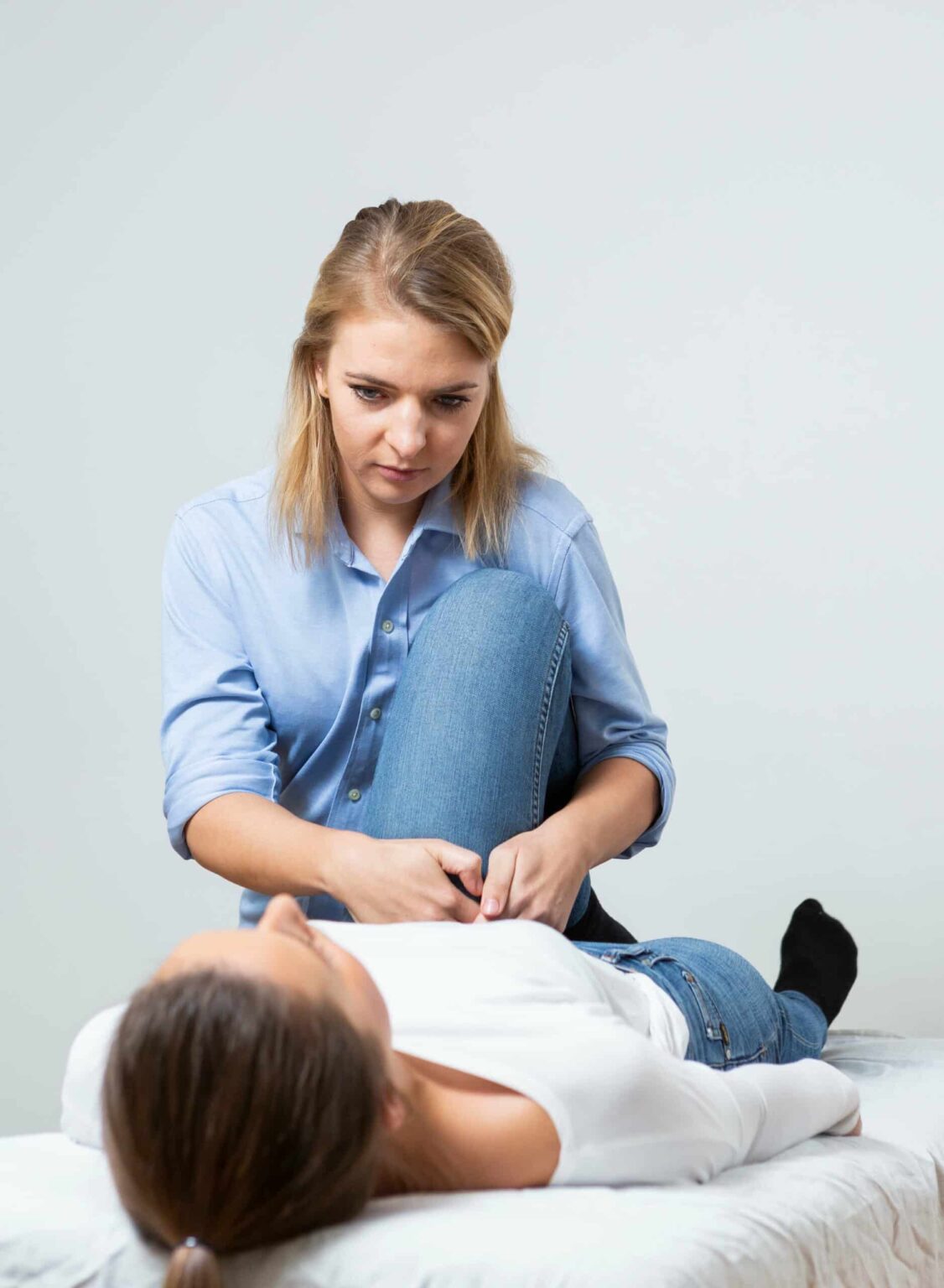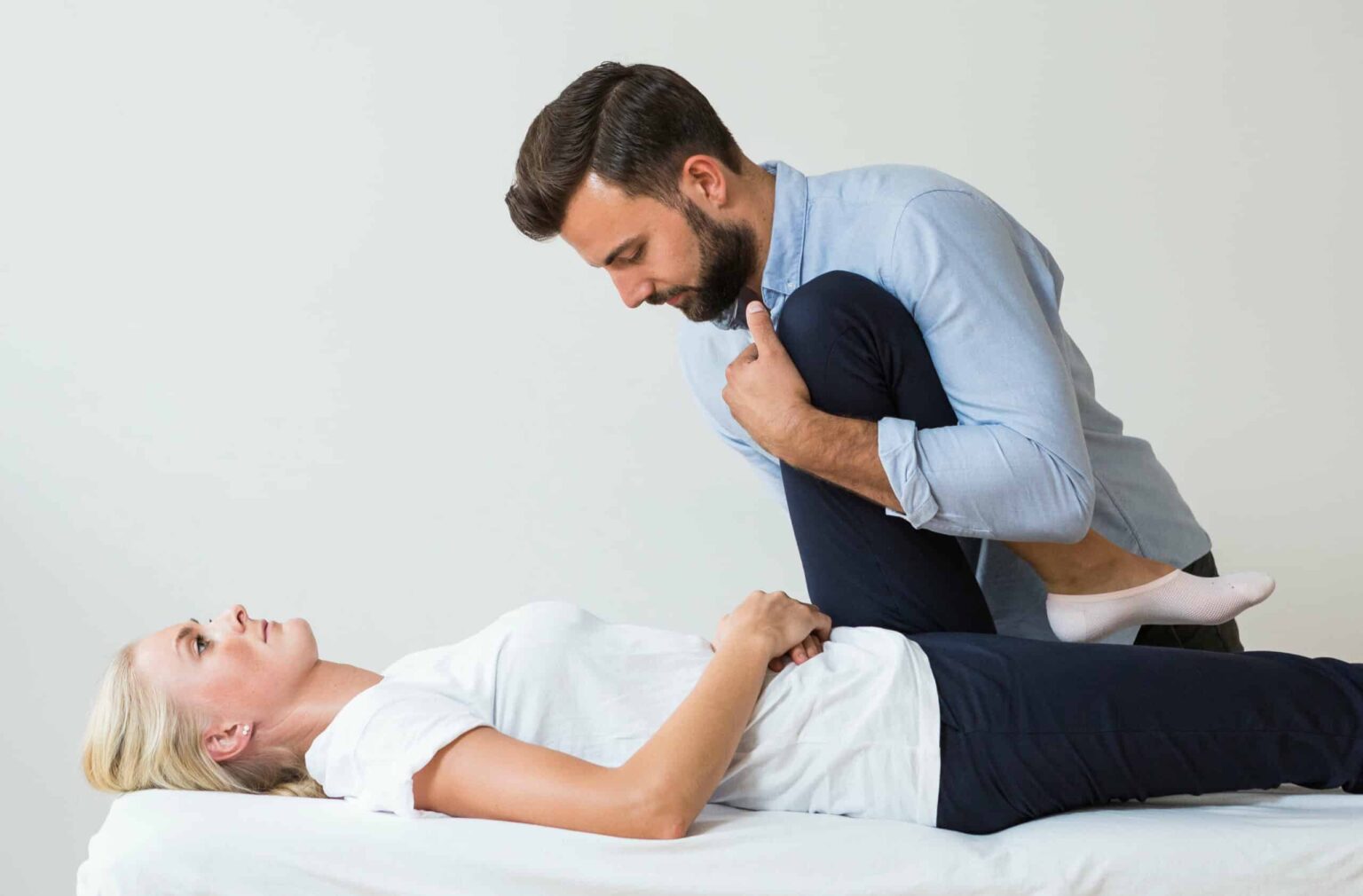We treat
Snapping hip
Learn more about Coxa saltans
What is a snapping hip?
Snapping hip, also known as “coxa saltans”, is characterized by a “pop” or “click” sound in the hip/groin area during movement. This may also be accompanied by pain, but not necessarily. It can feel uncomfortable and like the hip is “popping out of joint and back in again” and like the hip is “giving way” during a movement.
Jump to section [Vis]
Often occurs in athletes
This condition is most often seen in active athletes with a monotonous work pattern, such as runners, football players and ballet dancers.
These athletes are also the ones who most often report hip pain, with rates of 11%, 13% and 44% respectively.
Snapping hip is not dangerous, but more of an irritation, and often does not require treatment unless it is accompanied by pain, lack of strength, and loss of functionality.
Source: Sundhed.dk

Different types of snapping hip and causes
There are 3 different types of snapping hip.
External snapping hip
This form is caused by a too tight tendon on the outside of the thigh (tractus iliotibialis) or the tendon from the large buttock muscle (gluteus maximus). The tightness means that the tendon will “catch” a bone protrusion on the outside of the hip (trochanter major) when the hip is bent and extended. In addition, we have a mucous sac (bursa), which sits between the bone and the tendon. Due to the increased pressure from a tight tendon, which presses on it repeatedly, the mucous sac will become irritated. This will create an irritation of the mucous sac (bursitis trochanteria), and this is responsible for the pain.
Internal snapping hip
This type is caused by the hip flexor (iliopsoas) and its tendon, which will roll over the femoral head (caput femoris) and pubic bone (pecten ossis pubis). The familiar “click” or “pop” sound will occur, which may be accompanied by pain, when the hip is extended from a bent position. An inflammatory condition of the bursa (iliopectineus bursitis), which lies between the hip flexor tendon and the pubic bone, can also develop.
Source: Physio-pedia.com
Intraarticular snapping hip
This kind is due to a problem with the hip joint.
It can be caused by several things, including a labrum injury, bone-cartilage protrusions (osteo-cartilaginous exostoses), or a traumatic injury such as an accident or fall.
This type will often feel a locking in the hip and with pain deeper in the groin, which can radiate down towards the knee. What often gives rise to the symptoms is the rotation of the hip joint. The amount of pain will vary depending on the extent of damage to the surrounding structure/tissue, but gradually increases over time.
There is limited knowledge about the general cause, but it is not just one thing that is to blame. It is often multifactorial. It is also believed to be related to, among other things, strength around the hip, one’s feet (flat feet), knock knee condition and hypermobility.
Source: https://www.ncbi.nlm.nih.gov/pmc/articles/PMC4961351/

Symptoms of snapping hip
Symptoms are often an audible clicking or popping sound from the hip/groin area with possible pain during and after hip movement. However, this pain can worsen and persist for several hours/days depending on how active you are and how widespread the irritation is.
In some cases, there may also be radiating pain down to the knee and a lack of strength in the hip/leg, which is why some people start to limp.
The symptoms get worse with activity and with external hip dislocation there may also be pain when lying on your side.
You should be aware of whether the hip/groin, after an accident, has started to hurt and is increasing in character over time, as this may mean that an injury has occurred inside the hip.
In addition, in some cases, you may experience a popliteal fossa after hip replacement surgery due to the angulation of the new hip.
Diagnosing snapping hip
The diagnosis of snapping hip is often based on how it occurred, what the history is, and some clinical examinations and tests.
These examinations and tests often involve placing the leg/hip in a specific position.
To this end, the area will be felt and the strength and length of the muscles will be tested, as well as the mobility of the hip.
Many will be able to reproduce their symptoms to professionals by having the clicking or popping sound, and possible pain, repeated with movement. This will be felt and often heard.
If there is any doubt as to whether it is an internal snapping hip or Intra-articular snapping hip, ultrasound scanning is used, and possible follow-up scans such as MRI scans with contrast or, in rare cases, hip arthroscopy (binocular surgery).
Source: Physio-pedia.com

Treatment options for snapping hip
It will not require any treatment or surgery as long as it does not interfere with your daily life. However, if it is causing symptoms, there are various options you can try to treat snapping hip.
In general, you can start by trying exercises to increase the flexibility of the muscles and strengthen the muscles. This will activate the right muscles when you move the hip, thereby maintaining the natural dynamics of the joint.
In connection with the training, some will do, or may need, the use of NSAIDs, i.e. pain-relieving and anti-inflammatory medications. This is to reduce irritation from the tissue and relieve pain during the process. Sometimes one/more blockades will also be offered. This is to try to reduce the pain and irritation very locally, where the pain is believed to come from.
Several studies have been conducted on this problem, and they have found that the majority can be remedied. How quickly and effectively it resolves varies greatly from person to person, as it depends on the type of snapping hip, how long you have had it, whether you have received a correct diagnosis, and how well you adhere to the treatment that is initiated.
If there is still no improvement, surgery may be required to remedy the problem.
Source: Ortoklinik.dk
Surgery for snapping hip
During an operation, it can, for example, be for an internal snapping hip. Here, a tenotomy will be performed. This is where the hip flexor tendon is cut where it attaches to the femur. This is to allow the tendon to grow firmly onto the tissue of the hip joint capsule. This allows for a functional lengthening of the tendon.
It is about lengthening the tissue, so in the case of an external snapping hip, an operation will lengthen the tendon on the outside of the hip (tractus iliotibialis / gluteus maximus tendon).
In both cases, it may be necessary to remove the mucous sac; this is not always the case, but will depend on a number of individual variables.
In the case of intra-articular snapping hip, it will depend on what the problem is. If the problem is a labrum injury, then a laparoscopic surgery will often be performed.
This will often mean that after the operation, reduced strength over the hip, soreness and possibly reduced mobility can be expected for a limited period of time.
Therefore, it is also important that after the operation, contact a therapist (osteopath/physiotherapist) who will be able to help regain strength, reduce soreness and regain normal mobility in the hip.
Source: Ghp.dk

Osteopathic treatment
Osteopathic medicine emphasizes the connection and cooperation of the whole body. Therefore, we will look at the reason why it has arisen and what the triggering factor could be, so that you will be able to keep it away.
The treatment will consist of looking at the entire body, both mechanically, for example, the foot, ankle, knee, hip, lower back, etc.
In addition, the organ system and digestion are looked at. This is because it encourages optimal blood supply, thereby improving healing. It will also optimize the nervous system so that it is not overworked, so that the muscles and connective tissue will not be in the same state of tension. This creates an overall picture of the body’s function and condition. In addition to this, the social/emotional and psychological stressors will be looked at. This involves how you feel on a daily basis, whether you are pressured at work, socially or have some family problems that are taking up a lot of your time.
This is to gain insight into your and your body’s ability to handle everyday life, the injury, healing, movement, etc. It’s all connected, so the purpose is to create as good a picture of the whole person as possible in order to make a plan and advise as best as possible. This advice could involve everything from exercises, tools for managing stress levels, sleep, etc.





